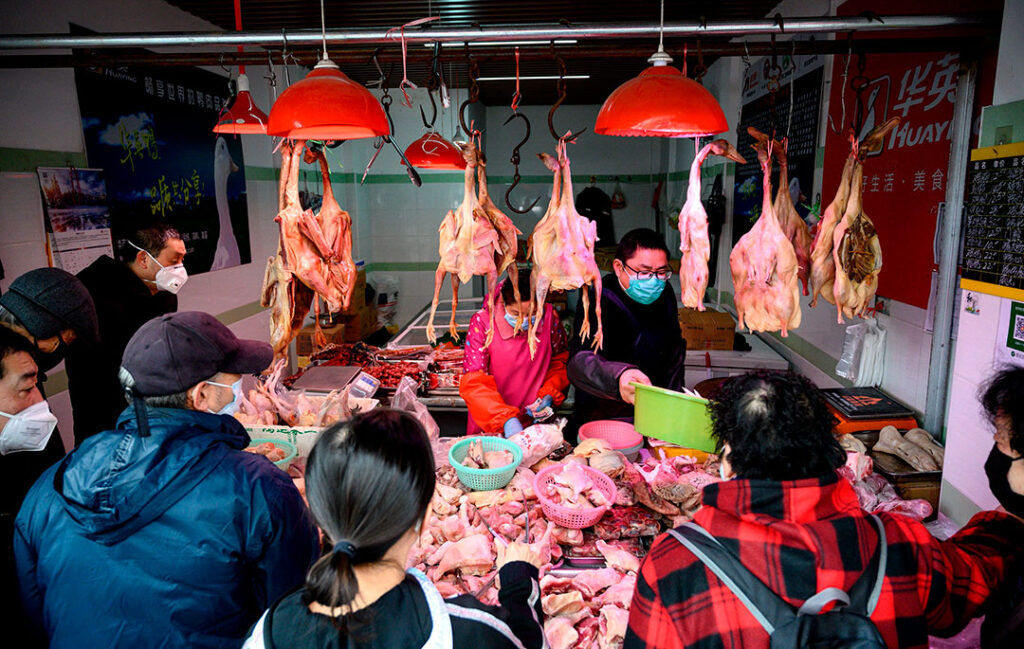A 57-year-old shrimp dealer at a Wuhan, China, “wet market” started out thinking she had a cold, but she became one of the first known people to contract SARS-CoV-2, the virus that causes COVID-19, in December 2019.
Doctors said her illness was “ruthless” — and that she was not alone. About two dozen people connected to the Huanan Seafood Wholesale Market had tested positive for COVID-19, according to The Economic Times, an Indian newspaper. The infections point to the wet market as a source.
In the busy Wuhan market, and others like it worldwide, live animals are kept in cages and pens such that pathogens and body fluids can seep from one container to the next. Meat is butchered, packaged and sold in these markets.
“It was not a surprise at all, and I think that it was not a surprise to many scientists,” Peter Li, associate professor at the University of Houston-Downtown, and an expert on China’s animal trade, told Vox for a video report. “The cages are stacked one over another. Animals at the bottom are often soaked with all kinds of liquid — animal excrement, pus, blood — whatever liquid they are receiving from the animals above.”
COVID-19, which is spread to humans by animals and insects, is a zoonotic disease. Such illnesses are caused by bacteria, fungi, parasites and viruses. Ebola is thought to have originated with bats. HIV came from chimpanzees. Influenzas commonly emerge from birds and pigs. Other zoonotic diseases are anthrax, bubonic plague, dengue fever, E. coli, Lassa fever, Lyme disease, malaria, salmonella, West Nile virus, yellow fever and Zika.
It is estimated that more than six of every 10 infectious diseases can be spread to people by animals, according to the U.S. Centers for Disease Control and Prevention. Three out of every four emerging infectious diseases are zoonotic. With SARS-CoV-2, the likeliest animal culprits are bats or endangered pangolins.
In 2003, severe acute respiratory syndrome, or SARS, emerged in a similar wet market and spread to 29 countries before abating, according to Vox. SARS killed almost 800 people. COVID-19 had spread to more than 200 nations and had killed nearly 50,000 as of April 2, 2020.
China’s wet markets commonly offer wild and domestic animals, a move rooted in a government decision from the 1970s, according to Vox. At that time, millions were starving in China. So the government relinquished some control of food production and allowed private farming.
Some peasant farmers started catching and raising wild animals, such as snakes and turtles, for food. The thinking was that if people could feed themselves, that was better for the nation.
In 1988, according to Vox, China declared that the state would own wildlife resources. The law also encouraged people to breed and domesticate wildlife. The industry grew, and a bigger variety of animals ended up in wet markets, increasing the likelihood that illnesses could spread.
The practice also provided cover for the illegal animal trade as more exotic species were trafficked into China, Vox reported. The risk became a reality when SARS emerged from a wet market in China’s Guangdong province. According to the World Health Organization, the animal vector may have been bats, which passed it to civet cats, and then to people.
China shut down the market and banned wildlife farming at the time but reopened it months later to a large slate of wild animals. Since the COVID-19 outbreak, China has shut down about 20,000 wildlife farms that raised everything from civet cats to ostriches and peacocks to porcupines, according to The Guardian. Chinese officials now are seeking to change wildlife protection laws.
“The coronavirus epidemic is swiftly pushing China to reevaluate its relationship with wildlife,” Steve Blake, chief representative of WildAid in Beijing, told The Guardian. “There is a high level of risk from this scale of breeding operations both to human health and to the impacts on populations of these animals in the wild.”
Although wildlife farming was an infinitesimal part of China’s overall economy, it had enormous lobbying power, Li told Vox. In 2016, China allowed farming of endangered animals such as pangolins and tigers. Pangolins have been shown to carry viruses similar to the one that causes COVID-19. “The industry has been promoting these wildlife animals as tonic products, as body-building, as sex-enhancing, and, of course, as disease-fighting,” Li said. “None of the claims can hold water.”
Despite this, such products are popular with influential people in China. “The majority of the people in China do not eat wildlife animals,” Li said. “Those people who consume these wildlife animals are the rich and the powerful. A small minority. This parochial commercial interest of a small number of wildlife eaters are hijacking China’s national interest.”
After the COVID-19 outbreak, China shut down wet markets and banned wildlife trade again. Interests from across the globe have urged China to make the ban permanent.
According to The Guardian, China’s National People’s Congress released new measures in late March that restrict wildlife trade, ban consumption of bushmeat and the sale of wildlife for meat at wet markets until the Wildlife Protection Law is amended and adopted. But the moves do not address operations that breed for traditional Chinese medicine, and fur and leather, which are known to drive poaching.

